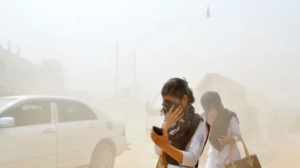Written by: Sakura Takahashi
As we are embarking near the end of 2024, Dhaka is experiencing a troubling déjà vu, continuing its trend of severe air pollution. On 10th December, Dhaka city topped global charts with an AQI score of 244, categorizing the air as “very unhealthy” and posing significant health risks to its residents. This alarming pattern mirrors the end of 2023 when Dhaka also ranked as the city with the worst air quality worldwide.

Photo: Dhaka Tribune
With such persistent pollution levels, one must ponder: “What will it take for us to turn this situation around? Are we capable of implementing effective solutions, or have we reached a point where the damage is irreversible?”
The ongoing struggle against air pollution in Dhaka raises critical questions about our collective responsibility and the urgency for action. As we look ahead, will we prioritize cleaner air for future generations, or continue down this hazardous path?
The situation is exacerbated by a combination of factors: unregulated industrial emissions, rampant vehicle pollution from poorly maintained vehicles, and widespread construction activities that contribute to airborne dust and debris. Despite these alarming trends, effective measures to combat air pollution remain largely absent, leading many to question whether we can still reverse this trajectory or if we have indeed reached a point of no return.
In recent weeks, Dhaka has been reported as having THE most polluted air globally, with hazardous levels of particulate matter (PM2.5) affecting daily life. Residents of Dhaka are experiencing increased health issues related to respiratory problems, and many are questioning the effectiveness of existing measures to combat this crisis. In this city, the air quality index (AQI) often reaches levels that are deemed extremely unhealthy, prompting warnings from local and international health officials about the dangers of prolonged exposure.

Photo: Dhaka Tribune
Contributing Factors:
Dhaka’s severe air pollution crisis can be attributed to several critical factors:
- Industrial Emissions: Factories and construction sites around the city are major sources of pollutants. For example, brick kilns, which are prevalent in the outskirts, release large quantities of smoke and particulate matter, significantly compromising air quality.
- Vehicle Emissions: The rapid increase in the number of vehicles on the roads exacerbates pollution. Many older vehicles, such as buses and rickshaws, lack modern emissions controls, contributing to the problem. For instance, a single diesel-powered bus can emit as much pollution as dozens of newer models.
- Waste Burning: Open burning of waste is a common practice in many neighborhoods. Residents often burn plastic and other refuse to dispose of it quickly, releasing toxic fumes that linger in the air for a long time. This practice not only contributes to poor air quality but also poses serious short and long-term health risks to those living nearby.
Public Response and Action
The citizens of Dhaka are increasingly vocal about their dissatisfaction with the government’s response to air pollution. Many are advocating for stricter regulations on emissions and better urban planning to reduce congestion and pollution. However, despite public outcry, tangible changes have been ridiculously slow to materialize.
As we look toward 2025, the urgency for “collective action” has never been more evident.
Some key areas that require immediate focus:
Government Initiatives
Robust policies and stringent enforcement against industrial emissions and vehicle pollution are essential. The government must prioritize the implementation of existing regulations, such as the Clean Air Act, and enhance monitoring systems to ensure compliance. This includes tackling emissions from brick kilns, which are a significant contributor to Dhaka’s air pollution.
Community Engagement
Raising public awareness is crucial in fostering a culture of environmental responsibility. Community campaigns can empower individuals to adopt sustainable practices, such as reducing vehicle use and supporting local clean-up initiatives. Engaging citizens in these efforts can lead to meaningful change at the grassroots level.
Green Solutions
Investment in green technologies and infrastructure is vital for long-term pollution mitigation. This includes adopting modern construction techniques that minimize dust emissions and utilizing drone technology to identify pollution hotspots. Furthermore, transitioning to electric vehicles and promoting public transport can significantly reduce vehicular emissions.
As we ponder these strategies, we must also ask ourselves: Are we prepared to take decisive action, or will we continue to allow air pollution to dictate our health and environment? The path forward hinges on OUR commitment to change.
Information is taken from :
[1] https://en.prothomalo.com/environment/xnmlobdcyn
[2] https://www.tbsnews.net/bangladesh/environment/last-year-dhaka-residents-breathed-good-air-only-8-days-768518
[3] https://www.thedailystar.net/environment/pollution/air-pollution/news/bangladesh-breathed-worst-air-last-year-3570656
[4] https://www.iqair.com/bangladesh/dhaka
[5] https://www.tbsnews.net/bangladesh/environment/dhaka-ending-2023-worst-world-air-quality-767082
[6] https://aqicn.org/country/bangladesh/
[7] https://gsconlinepress.com/journals/gscarr/sites/default/files/GSCARR-2024-0133.pdfThe Current State of Air Quality



Leave A Comment